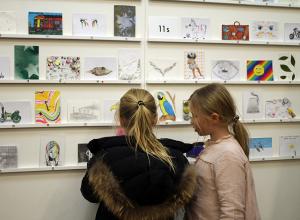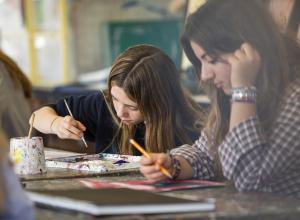Harrodian History of Art students have been busy visiting exhibitions this term and have approached them with a critical eye, considering the aims of the curators and the viewer’s experience. Here are some of their highlights and reviews.
Mixing It Up: Painting today (Hayward Gallery -- open until December 12)
Lower Sixth student Dora visited Mixing It Up and was excited to see an entire exhibition dedicated to contemporary painting. She says:
‘I loved the combination of artists and being able to compare all their interpretations of the world and their separate messages. Seeing how they used very similar materials to create such complex stories was fascinating. The exhibition delivered exactly as it promised in truly ‘Mixing it Up’.
My favourite artist in the exhibition was Mohammed Sami, who was born in Baghdad in 1984 and now lives and works in London. His paintings draw on memories of the chaos that engulfed Iraq following the US-led invasion in 2003. He conveys the psychological effect and trauma left after the conflict rather than the conflict directly.
His painting ‘Electric Chair’ was featured in the exhibition and captured my attention because of the bright use of complementary colours which contrast with the dark background. The title of the piece connotes violence and punishment but the chair depicted appears more like a throne, implying wealth and privilege. The dark colour of the background really enhances the saturated blue of the velvet chair and also the glistening gold. I learned that this painting actually depicts a throne used by Saddam Hussein. The ornate moulding and velvet seat create a striking contrast with the painting’s sinister title - a reference to the fate met by many opponents of the dictator’s regime.’
Harrodian History of Art teacher Hannah Kroes also appreciated the effort of ‘Mixing It Up’ to celebrate contemporary painting in Britain. She writes:
‘Contemporary painting is experiencing a renaissance and the exhibition is an excellent survey of the medium today. Visiting ‘Mixing It Up’ is a different kind of exhibition experience because there is no conceptual thread linking all the work shown and there is very little wall text. This provides the viewer with the freedom to make connections between disparate artworks, and I particularly enjoyed the dialogue that this created between the work of Lubaina Himid and Lisa Brice in the first room and between Samarra Scott and Rachel Jones upstairs. For anyone who wonders where the art world is heading, this exhibition offers excellent insight.’
Poussin and the Dance (National Gallery -- open until January 2nd)
Upper Sixth student Imogen writes:
‘Poussin used the form of dance to transform the classical world. He used wax models to drape the fabric/clothing suited to the figures he would paint. Poussin used extremely vibrant and crisp colours in his compositions, and the placement and positions of the figures were crucial to the composition coming alive: following the figures across the canvas as they ‘dance’. One of my favourite works was A Bacchanalian Revel before a Term, because the placement and execution of the shadows in the material drew me to the image as it created an extremely fluid and dancelike effect.
’
Lower Sixth student Romy continues:
‘When I entered the National Gallery a few weeks ago to see Poussin and The Dance I was expecting a beautiful but relatively dry afternoon, wandering around the gallery looking at the traditional and often cold paintings of Nicolas Poussin (1594-1665). This exhibition, however, brought Poussin and the ancient world to life completely and I left not only more knowledgeable about Poussin and his work but also having had one of the most enjoyable and immersive gallery experiences of my life.
This exhibition put a new spin on Poussin’s works, displaying them alongside the ancient artefacts that they were inspired by. Stepping into the gallery and having the opportunity to view the artefacts that inspired him felt like travelling through time.
Part of the brilliance of the curation of this exhibition was tying these artefacts right back into the present. Rather than only highlighting the brilliance of the paintings themselves, it displayed the process behind each work of art. This gave the visitors an insight into the wonderful world of Poussin whilst also demonstrating his genius. To ‘choreograph’ the dances inside his compositions, Poussin first built wax figurines which he arranged into a kind of ‘model theatre’, moulding and remoulding until he had created the perfect positions for him to paint. He could study these figurines from all sides, which meant that he was able to create the effortless flow and dynamism that we see within his paintings. At the gallery, his paintings were displayed alongside estimations of what such models may have looked like, giving the viewer an immersive experience into the world and process of the painter. This was not only incredibly interesting but also tied Poussin’s work right back into the present. Being able to see his work, the pieces that inspired him and a modern interpretation of his models all in one room brought thousands of years of history together, an almost transcendental experience. The contrast between the long, painstaking modelling process the artist went through and the raucous, wild, free and flowing dance scenes he portrayed only further highlights his genius.
Above: The Triumph of Pan (c.1636) and wax models
One of the most impactful pieces in the exhibition was the famous ‘A Dance To The Music Of Time’ (c.1634). In this painting, the human condition is represented by four figures (representing Poverty, Pleasure, Riches and Labour) dancing in a circle to the music of Father Time who is playing the lyre for them. Not only is the painting itself beautiful and incredibly philosophical but the exhibition included the Roman (2nd Century) marble relief sculpture that inspired the piece, ‘The Borghese Dancers’. In the sculpture the Hours (Goddesses of time) hold hands and seem to dance. Being able to see Poussin’s great work next to the breathtaking original sculpture is a perfect example of the way in which the exhibition seems to reach into history whilst still making the art feel relevant to the contemporary viewer.
Above: The Borghese Dancers (2nd Century) and A Dance To The Music of Time (c.1634)
This exhibition gives a completely new perspective on paintings from over 400 years ago. It draws together beautiful paintings, important historical antiquities and modern recreations to create an experience that is insightful and joyous, and celebrates the very act of artistic creation.’
Noguchi (Barbican Art Gallery -- open until January 23rd)
The Barbican’s exhibition of Japanese artist and designer, Isamu Noguchi’s work has been one of the favourite exhibitions amongst Harrodian students. Upper Sixth student Minnie writes:
‘The Noguchi exhibition, situated at the Barbican, displays a vast breadth of Noguchi’s artworks, from sculpture to lighting and furniture design. Each room contains a differing theme aiming to portray Noguchi’s progression as an artist and his modernisation of the sculptural technique.
Much of Noguchi’s sculptures were vast and vibrant, however, I was particularly drawn to a tiny photograph, stuck to a wall near the floor in the exhibition. The picture was of a conceptual piece, “Man to be seen from mars” and though never created, I liked the message behind it. Noguchi proposed the idea in response to an increasing sense of hopelessness following the Cold War. The human face was to be large enough to be observed from space, as a memorial to the species in case it obliterated itself and to inform others that civilized life once existed on earth.
The exhibition was really well laid out and the booklet contained drawings of each of the pieces, making them easy to identify. The space, which was largely geometric, perfectly contrasted Noguchi’s biomorphic sculptures and the separate rooms helped to clearly delineate his differing aims as an artist.’
Lower Sixth student Rita further comments:
‘The artwork that I liked the most is the “Martha Graham’s Cave of the Heart Spider Dress and Serpent” because it is made from brass wire and bronze, which are unusual materials for the dress. By making this dress Noguchi wanted to express his love for the dancer. The function of this dress is to extend the sculptural possibilities of body weight, mass and gravity. I like that by making this dress Noguchi broke the standard boundaries of presenting the human body and dress-making.
“Martha Graham’s Cave of the Heart Spider Dress and Serpent” 1946
In general, I liked the exhibition, because I think that the layout of the second floor of the exhibition is very successful as it is divided in eight parts and each of them present different stages of Noguchi’s career. I liked how artworks of different scales are placed next to each other, which makes the layout even more interesting. For example, the two works “Memorial to the Dead, Hiroshima” and “Akari” were placed next to each other and I think this adds a new meaning to these sculptures.’







